Is Earth safe from asteroids and comets?
Expert reviewers
Essentials
- Earth regularly collides with stuff from space, but those objects are usually too small to cause damage.
- Past collisions have shaped Earth’s history: from the formation of the moon to the extinction of species.
- The likelihood of a catastrophic asteroid collision is incredibly low, but they do happen over time—and the damage they can cause is incredibly high.
- There are a number of options being investigated for preventing collisions, but we don’t yet have a comprehensive defence system.
Collisions with asteroids, comets and other stuff from space have been responsible for huge landmarks in our planet’s history: global shifts in climate, the creation of our moon, the reshuffling of our deepest geology, and the extinction of species.
Asteroid threats pop up in the news every now and then, but the buzz tends to fizzle away as the projectiles pass us by. Other times, as with the 2013 Chelyabinsk meteor in Russia, we don’t know they’re here until they’re here.
So how worried should we be about collisions from asteroids and other projectiles from space? And what can we do to try to prevent a collision?
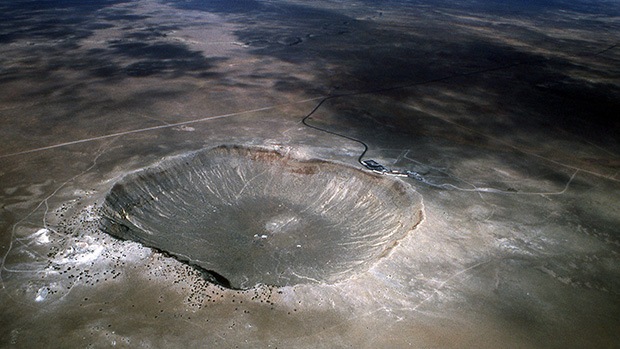
A celestial stocktake: what’s out there?
The objects in our solar system come in many different shapes and sizes and with lots of different names, so let’s start by clearing up some terminology.
- Planet
- A large, round object that orbits a star and has an orbit that’s mostly clear from other objects. Planets come in different varieties: rocky planets GLOSSARY rocky planetsPlanets that are mostly composed of rocks or metals. like Earth; gas giants GLOSSARY gas giantsPlanets mostly composed of light elements with low boiling points, like hydrogen and helium. like Jupiter; and ice giants GLOSSARY ice giantsPlanets mostly composed of heavier elements with low boiling points, like oxygen, carbon, nitrogen and sulfur. like Uranus.
- Moon
- A celestial body that orbits another celestial body that isn’t a star. They don’t necessarily need to orbit planets—sometimes they orbit asteroids or dwarf planets.
- Dwarf planet
- A large object that doesn’t meet all the criteria to be either a planet or a moon. They include Pluto, Eris and Ceres.
- Meteoroid
- A small rocky object in space, considerably smaller than an asteroid (typically, no bigger than 10 metres across).
- Asteroid
- A rocky object that orbits the sun, smaller than a dwarf planet but bigger than a meteoroid. Asteroids usually have an irregular (non-round) shape, because they don’t have enough gravity to squish them into a ball.
- Comet
- An object made of ice and dust. They look different from asteroids because of the distinctive tail (or tails) of particles that stream behind them, caused by sublimation GLOSSARY sublimationThe equivalent of melting in space. Heat melts the ice, which boils off into space and then freezes again … we see those ice crystals twinkling in the sunlight as the tail of the comet. .
- Meteor
- An object from outer space that enters Earth’s atmosphere. When they hit the atmosphere at night, they’re seen as shooting stars (and if they’re extremely bright, they are also known as fireballs or bolides). Most are no larger than a grain of sand. Comets, asteroids and meteoroids can all become meteors.
- Meteorite
- A piece of rock or metal that has fallen to the surface of Earth from outer space. If they’re big enough, meteors become meteorites when they hit the ground. We can learn a lot about asteroids and planets by studying meteorites that fall to Earth.
- Near-Earth object
- A small (non-planet) object in the inner solar system. Despite the name, they can still be quite far away from Earth during most of their orbit.
Perhaps most useful to remember is that when near-Earth objects (including asteroids, comets and meteoroids) enter the atmosphere, they’re called meteors; and if there’s anything left when they hit the ground, the resulting object is called a meteorite. We tend to focus on asteroids when talking about potential collisions, because they’re more likely to hit us than other stuff like comets, but still big enough to pose a threat.
- In space
- asteroids
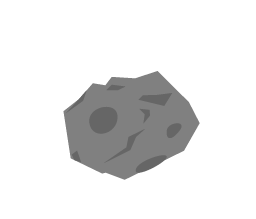
- comets

- meteoroids

- asteroids
- In the atmosphere
- meteors

also called “bolides” or “fireballs” if they’re bright
- meteors
- On the ground
- meteorites

- meteorites
Where do asteroids and comets come from?
Asteroids and comets aren’t rogue wanderers flying through space—they orbit the sun, just like the planets. Here are a few key areas where they’re found, ordered by their proximity to Earth.
- Asteroid belt
- Located between Mars and Jupiter. Thought to harbour over a million asteroids larger than a kilometre wide (and even more smaller ones, too).
- Trojan asteroids
- Orbit the sun in the same path as Jupiter, trailing in stable positions in front of and behind the giant planet.
- Kuiper belt
- Located beyond the orbit of Neptune. Is thought to have an estimated trillion or more comets. It also contains the dwarf planets Pluto, Haumea and Makemake.
- Oort cloud
- The Oort cloud has not been directly observed, but is thought to be a sphere of icy debris that surrounds our solar system, stretching out so far that it nearly reaches the next-closest star from the sun. If it exists, it probably contains billions or trillions of comets, and is potentially the source of long-period comets GLOSSARY long-period cometsComets that take hundreds or thousands of years to complete their orbits, like Hale-Bopp, last seen in 1997 and next expected to be seen from Earth in the year 4380. .
The vast majority of these asteroids and comets will never come close to our planet. To understand why, it’s worth taking a brief tour of how the solar system formed.
The building blocks of planets
Before our solar system was the solar system, it was a huge cloud of dust and gas (mostly hydrogen). It started clumping together under the influence of gravity, and little clumps of dust moved and collided with other little clumps, with their overall movement stabilising into a spinning disc.
Some objects clumped together more quickly, giving them more gravity and surface area than other bits of matter. This made those objects more likely to accrete GLOSSARY accreteCome together under the influence of gravity. more matter, and so they became even bigger as they moved through space. The centrepiece became the sun. Around it, the planets formed—large bodies that cleared their orbits by collecting or pushing apart all the stuff in their way.
Asteroids can be thought of like the building blocks of planets (they’re sometimes called planetoids or minor planets). The jury’s still out on exactly why the objects in the asteroid belt (or Kuiper belt) didn’t form into planets, though the gravity of Jupiter is thought to have played a key role in agitating their orbits. Regardless of their size, these objects tend to stay in their orbits, far from Earth.
But occasionally, asteroids and comets are nudged by the gravity of nearby planets into orbits closer to us, becoming near-Earth objects. These ‘nudged’ asteroids constitute a tiny fraction of all those in the solar system, but there are still a lot of them. And they can—and do—hit us.
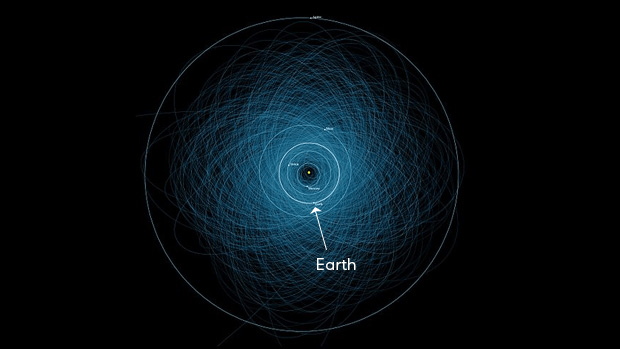
Earth’s pockmarked past
Collisions with asteroids and other bodies in space aren’t rare for Earth, even on the timescales of our own lives. Small meteoroids about a metre wide hit the atmosphere about once a fortnight, becoming little more than a shooting star. But past collisions with bigger offenders have caused dramatic changes to our planet.
The (proposed) story of our moon
The biggest collision Earth has faced is the one that (probably) led to the formation of the moon. Under the leading—but still debated—hypothesis of the moon’s formation, around 4.5 billion years ago a protoplanet GLOSSARY protoplanetLarge bodies that are thought to still be accreting matter and developing. If their orbits stabilise, they end up as dwarf planets or planets. known as Theia collided head-on with Earth. Theia was almost the size of what Mars is today, and the collision between these two huge bodies changed the course of our planet forever: it ripped off part of our planet, changed the length of our days, changed the makeup of the Earth’s core, and created a band of rocky debris that eventually formed into the moon.
Not long after Earth collided with Theia, the solar system started to settle down. The planets had formed, and their orbits were de-cluttered. But that was not the end of the story.
The late heavy bombardment
Based on the ages of rocks that Apollo astronauts brought back from the moon, we know that something major happened around 4 billion years ago: the Late Heavy Bombardment. We don’t know exactly what caused this event—one idea is that the orbit of Jupiter flung Neptune into the outer solar system, and another is that the bombardment was caused by the late formation of Uranus and Neptune. Whatever happened, it created a gravitational shift that sent a barrage of asteroids from their orbits. Some hit Earth, some hit the moon, and most of the other planets of the inner solar system received hits too.
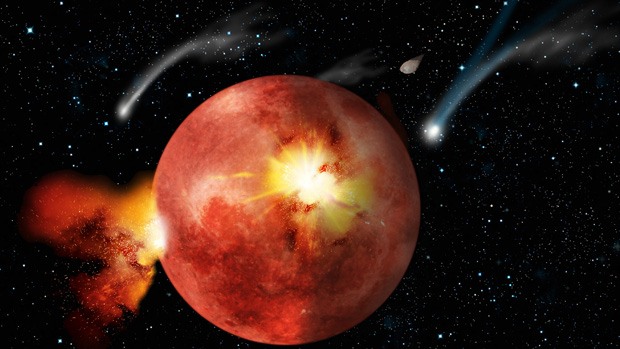
More recent collisions
Perhaps the most well-known collision is the one that formed the Chicxulub crater in Mexico, coinciding with the extinction of most of the dinosaurs. It threw a huge amount of dust and debris into the atmosphere, causing an impact winter GLOSSARY impact winterA long period of darkness and cold weather caused by dust and debris thrown into the atmosphere by an impact with an asteroid or comet. . This contributed to the extinction of around 60 to 80% of all living species. The energy released—equivalent to over a billion Hiroshima bombs—triggered a near-global firestorm that burned huge quantities of the ancient forests. This had flow-on effects that further contributed to environmental change.
Although this happened around 66 million years ago, it’s very recent in Earth’s 4.5 billion year history. More recent collisions haven’t been as extreme, but explosive impacts have still happened within the window of humanity—from the Tunguska event in 1908 to the Chelyabinsk meteor in 2013, we’ve come to learn that threatening asteroids are part of our cosmic environment.
So even though the rocky mass of Earth itself was resilient enough to survive a collision with a Mars-sized rock billions of years ago, our relatively recent life and climate is much more susceptible to the dangers of asteroids—and that means we’re susceptible, too.
Future collisions: how big? How likely?
Before you start planning your asteroid survival strategy, it’s worth noting that cataclysmic asteroid collisions are incredibly unlikely, due to the relative stability of our solar system and the vastness of space. But when you factor in millions or billions of years of time, we expect them to happen again.
The stable orbits of today
‘Stability’ is a tricky concept in the context of the solar system. There are still some collisions between smaller objects, and the orbits of planets will shift over time—so it’s not a pristine, unchanging system. But so much time has passed since the formation of the planets that most of the dramatic stuff seems to be out of the way. The vast majority of bits of matter bound for collision have already collided, and the orbits of bigger bodies have settled down.
Collisions are even rare within the asteroid belt—despite the rocky obstacle course that it tends to be portrayed as, it’s mostly empty space. The average separation between asteroids in the asteroid belt is around 1 to 3 million kilometres—so basically, it’s hard to hit anything in space these days, no matter where you are.
But the orbits in the solar system are part of a dynamic system, and small gravitational effects can add up in unpredictable ways. Plus, there are many moving pieces, including those 1,700 potentially hazardous asteroids—so it’s just a matter of time before the next one hits. The question is: how much time?
Likelihood statistics
In accepting the reality of potential asteroid and comet collisions, we have two main options in determining the likelihood of collision: first, to look at how often these events happen based on what we know about our planet’s past, and extrapolating that out to get a rough guide of how often impacts of various sizes occur; and second, to find and track the trajectories of asteroids that are out there today, and figure out which will hit us.
Collision size and frequency
Based on the past frequency of impacts with asteroids/comets and Earth, we can get a very rough guide of how often, on average, impacts occur. Slide the bar to see the collision frequencies of different sized objects.
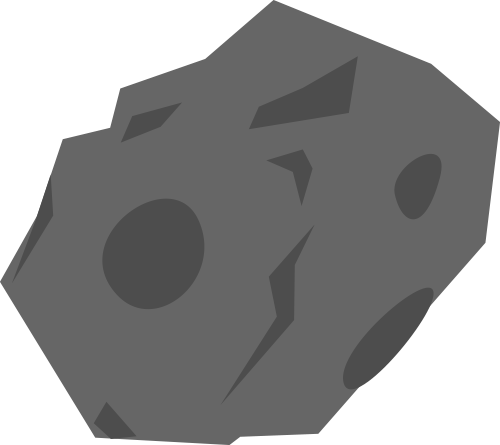

Size of asteroid/comet
[ANSWER] (diameter before hitting the atmosphere)
Approximate collision frequency
[ANSWER] (average interval between past collisions)
Energy released
Equivalent to [ANSWER]
Source: Adapted from French, 1998; some figures updated with more recent data from Brown et al., 2003.
Like most probabilities, these numbers are only useful as a guide—impact events don’t run like clockwork. And don’t forget that asteroids above a certain size have the potential for global catastrophe—they affect more than the place where they land.
But we don’t have to accept inevitable catastrophe, whether it’s now or far in the future. We may be able to prevent disasters. First, we need to locate the incoming projectiles.
Tracking what’s out there
Thanks to their streaking tails and reflective surfaces, comets are a visual treat for backyard astronomers (even without a telescope). Asteroids are much trickier to spot, being that they are dark objects in the darkness of space. So astronomers use infrared telescopes that track the heat that the asteroids absorb from the sun. We don’t pick up everything—particularly the asteroids that approach us from the direction of the sun, as the sun’s light blinds us and the light reflected by the asteroids is sent in the opposite direction.
Overall, though, while a few asteroids here and there slip under the radar, the ones that are missed tend to be the smaller ones. And based on what we know so far, there’s nothing out there raising alarm bells.
NASA’s NEOWISE (Near Earth Object Wide-field Infrared Survey Explorer) project freely publishes its discovery statistics, including orbit diagrams, impact probabilities, and past and upcoming close approaches. They have a huge database of near-Earth objects, but most of those that have been found have tiny, almost insignificant chances of hitting Earth. For instance, 99942 Apophis—an asteroid that receives occasional media attention, and shares its name with an ancient Egyptian god of chaos—is estimated to have only a 0.00089 per cent chance of making a direct hit in the coming years. But we still need to keep watch, as it might break into smaller chunks when it passes by in 2029.
Planetary defence
While the likelihood of any one large asteroid striking our planet is incredibly low, the immense damage they have the potential to cause makes them difficult to ignore. If we spotted an asteroid or comet that had us worried, what could we do?
Sending explosives to detonate it into smaller pieces is probably a bad idea, unless we could carefully control the explosion. Breaking one object into several could make it an even bigger threat, and certainly more difficult to track. So, more subtle options tend to stand ahead of the rest. Here are some proposed options.
- Tow it away
- A spacecraft could rendezvous with the asteroid or comet, then throw a bag or rope around it to tow it away. This will only work if the asteroid (or comet) is nice and solid, so it won’t break apart. It could also be tricky to do this for very large objects—imagine trying to build a robot that could throw a rope or bag over a 1 kilometre-wide asteroid while in space!
- Nudge it with gravity
- Another kind of tow truck, called a gravity tractor, could use the gravity of the spacecraft itself to slowly divert the asteroid. When the spacecraft gets near the asteroid, the gravity of the more massive object (the asteroid) will pull the less massive object (the spacecraft) towards it. But the asteroid will also move towards the spacecraft a tiny bit, too. You could fire the spacecraft’s rockets to move away and then repeat this process many times until the asteroid is no longer on a collision course with Earth.
- Paint it
- Painting one side of the asteroid white would alter the amount of heat it absorbs on that side. This could make a tiny shift in the direction it travels, which would add up over time.
- Attach a solar sail
- Wrapping an object with a solar sail, a bit like aluminium foil around a potato, could change the degree it reflects light, shifting its course.
- Shoot lasers at it
- This isn’t quite the solution you may think it is … rather than using lasers to blow up an asteroid, they’d be used to heat its surface and change its trajectory. Earth-bound lasers may not be powerful enough for this task (because it’s much easier to affect an object’s trajectory long before it reaches us), but a swarm of tiny craft sent close to the asteroid might do the trick.
These and other deflection strategies require a long notice period—the earlier we spot the threat and start planning, the less dramatic our efforts will need to be to direct it away. But while successful exploratory missions like Rosetta/Philae, Hayabusa and Hayabusa2 are essential stepping stones, we’re not yet able to claim we have a comprehensive planetary defence system.
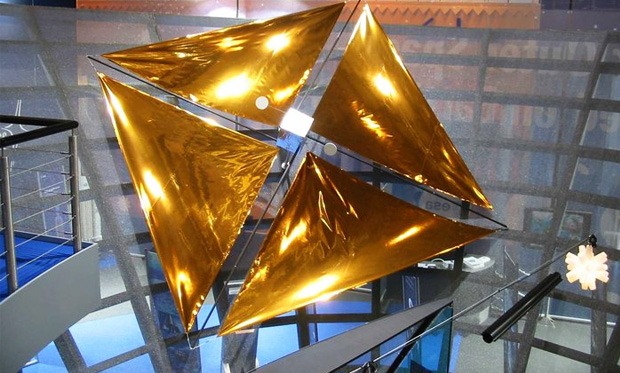
More than science and technology
Unfortunately, tracking asteroids and finding a great technology to divert them are not our only challenges. We are divided by country borders and have our own economies, laws and priorities. Who would fund and manage our planetary defences? What would we do if we were faced with a decision that could prevent a collision with one country, but put another at higher risk? What if we made a mistake?
Although Hollywood has created some colorful methods for stopping an object that is on a collision path with Earth, no government agency, national or international, has been tasked or accepted the responsibility to stop such an asteroid, should one be discovered.NASA
So while we shouldn’t be consumed with fear about asteroids today or tomorrow, it’s worth more than a passing thought of what we could—and should—do when faced with a threat in the future. Celestial collisions have the potential to change more than the face of our planet, so it seems wise to keep watching, thinking, and preparing.





